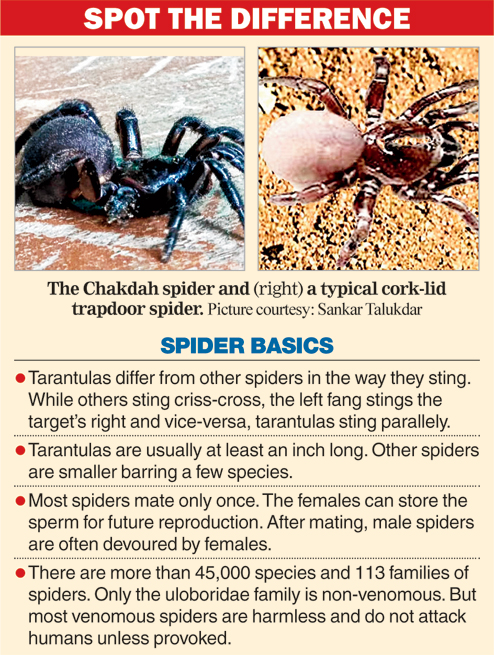
Jan. 12: The spider found in a garden in Nadia's Chakdah last Saturday probably belongs to a breed that has not been sighted in Bengal, according to an expert.
Sankar Talukdar, habitat biologist and arachnologist (expert in spiders and other arachnids) at the Zoological Survey of India (ZSI), said he would soon collect the specimen, which is preserved in the laboratory of a Chakdah college, and conduct tests to ascertain its type.
The spider died after a local resident had trapped it in a plastic container.
Taking a look at photographs of the Chakdah arachnid sent to him by Metro, Talukdar said it appeared to be a cork-lid trapdoor spider.
The dead spider is 2.5-inch long and has eight legs and two appendages, which is consistent with the morphology of cork-lid trapdoors. Such spiders belong to a family of medium-sized mygalomorphs or tarantulas called Ctenizidae.
These are crafty creatures that can camouflage their shelters with lid-like hinge doors and attack a prey as soon as it enters the trap. "That is how they derive their name," explained Sajal Ray, professor of zoology at Calcutta University.
Trapdoors, which do not spin a web to catch insects, are usually timid but can sting and bite. The bite can be painful. The venom though is of little risk to humans
Confirmation of the Chakdah spider's identity will, however, have to wait physical examination and tests.
There is no scientific documentation of the sighting of a cork-lid trapdoor in Bengal, said Talukdar, who has been researching arachnids for decades.
Only four sightings of cork-lid trapdoor spiders in India - in Arunachal Pradesh, Manipur, Mizoram and Odisha - have been documented, he added.
Once the Chakdah spider is brought to the ZSI lab, it will be kept in a solution of alcohol and acetic acid.
Zoologists will then perform a series of taxonomical tests - linked to classification of organisms - on the specimen. A morphology test, for example, will put the spider under the microscope. Its body parts, such as cephalothorax, abdomen and spinneret, would be examined.
DNA barcoding could also follow. DNA barcoding is an advanced technology that involves using a short genetic marker in an organism's DNA to identify it as a member of a particular species. It is somewhat similar to scanning the barcode on a supermarket product to identify a customer's purchase.
The DNA barcoding technology is still in its infancy at the ZSI but the institute can collaborate with other experts to carry out the test, suggested Ena Ray Banerjee, professor of zoology and head of immunobiology and regenerative medicine research lab at Calcutta University. Banerjee, an expert in molecular biology, also expressed interest in studying the Chakdah spider.
After the tests, the results will be compared with an existing database to infer if the spider is a member of a known family or a new species.
Metro had reported in last Sunday's edition that the spider had 10 legs. Talukdar explained that the appendages coming out of the thoracic (chest) region are usually called legs but those connected with the cephalic (head) region are called pedipalps.
The Chakdah spider has four pairs of appendages (legs) coming out of the thorax and one pair of appendages (pedipalps) coming out of the cephalic region.
In males, the pedipalps are swollen like a mace near the fang and serve as a reproductive organ.










